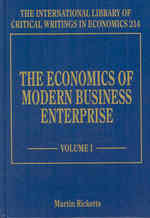- ホーム
- > 洋書
- > 英文書
- > Business / Economics
Full Description
The proper management of transportation processes and issues is critical to fulfilling customer demand, and to the ultimate success of a supply chain. Now, there's an authoritative and comprehensive guide to managing transportation processes and operations in any supply chain. Authored by leading expert Thomas Goldsby alongside the Council of Supply Chain Management Professionals (CSCMP), this text focuses on the key principles, strategies, and decisions required for the cost-efficient, effective flow of goods between sellers and buyers. Coverage includes: Basic transportation management concepts and their essential roles in demand fulfillment, including transportation links, efficiency, and aligning capabilities with customer requirements Key elements, processes, and interactions of transportation operations management, including transportation modes, execution, and control Design principles and strategies for establishing efficient, effective, and sustainable transportation operations, including functional control, terms of sale, outsourcing, modal and carrier selection, rate negotiation, contracting, consolidation, 3PLs, sustainability, and overcoming barriers to success The critical role of technology in managing transportation operations and product flows, including the latest TMS tools for routing, scheduling, load planning, carrier selection, load tendering, status tracking, appointment scheduling, performance reporting, scorecarding, and auditing Requirements and challenges of planning and moving goods between countries, including freight flows, intermodal options, planning/execution, ocean shipping and international air services; customs; global challenges, and regulation Best practices for assessing performance using standard metrics and frameworks, including KPIs, tradeoff analysis, and more
Contents
SECTION 1 TRANSPORTATIONChapter 1 Transportation in Business and the Economy 3 Transportation and Logistics 4 Transportation and the Supply Chain 6 Transportation and the Economy 7 Transportation, Society, and the Environment 10 Summary 12 Endnotes 12 Chapter 2 A Survey of Transportation Modes 15 An Overview of the Modes 15 The Five Modes of Transportation 17 Road Transportation 17 Rail Transportation 25 Water Transportation 31 Air Transportation 36 Pipeline Transportation 37 Intermodal Transportation 38 Summary 44 Endnotes 45 Chapter 3 The Economics of Transportation 47 Accounting Costs and Economic Costs 47 Fixed Costs and Variable Costs 48 Carrier Cost Metrics 50 Carrier Pricing and Costs for Shippers 54 Expressions of Transportation Rates 56 Additional Services and Fees 59 Summary 61 Endnotes 62 Chapter 4 The Transportation Services Market 63 Private Transportation 63 Private Road Fleets 63 Advantages of Private Road Fleets 65 Other (Nonroad) Private Fleets 66 Outsourcing Transportation 67 Contract Carriage (2PLs) 67 Third-Party Logistics Providers (3PLs) 67 Lead Logistics Providers/Integrators (4PLs) 70 Freight Forwarders 71 Difference Between 3PLs and Freight Forwarders 72 Brokers 73 Summary 74 Endnotes 74 SECTION 2 TRANSPORTATION FOR MANAGERS 77Chapter 5 An Overview of Transportation Management 79 Transportation Management Decision Making 79 Network Design 80 Typology of Transport Networks 81 Optimization 83 Heuristics and Simulations 84 Lane Analysis 85 Mode and Carrier Selection 90 Service Negotiations 94 Shipper-Receiver Negotiations 94 Shipper-Carrier Negotiations 96 Contract Versus Spot Rates 96 Contractual Provisions 97 Service Evaluation 99 Dock- and Movement-Level Decisions 102 Transportation Documentation 103 Documents Common to Domestic and International Transportation 104 Documents Exclusive to International Transportation 106 Summary 108 Endnotes 109 Chapter 6 Transportation Technologies 111 Understanding the Need for Technology: The Bullwhip Effect 113 Technology Architecture 115 Hosted Systems/Hosted Software 115 Software as a Service (SaaS) 115 Electronic Data Interchange (EDI) 116 What Is EDI? 116 Benefits and Applications of EDI 118 EDI Implementation 118 Transportation Management System (TMS) 119 Benefits and Applications of TMS 120 TMS Implementation 124 Routing and Scheduling (R&S) Systems 125 What Are R&S Systems? 125 Benefits and Applications of R&S Systems 126 R&S System Implementation 128 Automatic Identification 129 What Is Automatic Identification? 129 Bar Codes 129 The Serial Shipping Container Code (SSCC): A Special Tool in Transportation Management 130 Radio Frequency Identification (RFID) 133 Control and Monitoring Systems 136 What Are Control and Monitoring Systems? 136 Location Monitoring Systems 136 Temperature Control and Monitoring Systems 138 Summary 140 Endnote 141 For Further Reading 141 Chapter 7 Transportation's Role in Logistics and Supply Chain Strategy 143 Lean Logistics 143 Shared Transportation Resources 146 Merge-in-Transit (MIT) 147 Vendor-Managed Inventory (VMI) 149 Collaborative Planning, Forecasting, and Replenishment (CPFR) 150 Collaborative Transportation Management (CTM) 151 Summary 154 Endnotes 155 Chapter 8 Transportation and Global Supply Chains 157 Need for Global Supply Chains 160 International Modes of Transportation 161 International Ocean Transportation 162 International Air Transportation 168 Intermodal Transportation 174 Enablers and Key Players in Transporting Goods to Global Supply Chains 179 Incoterms 180 Key Documents Used in Enabling Transportation for Global Supply Chains 185 Summary 187 Endnotes 188 Chapter 9 Transportation and Sustainability 189 Transportation's Role in Sustainable Supply Chain Management 190 The Need for Sustainability in Transportation 191 Triple Bottom Line (TBL) 197 Potential Solutions to Make Transportation More Sustainable 199 Summary 202 Endnotes 203 SECTION 3 TRANSPORTATION IN 2013 AND BEYOND 205Chapter 10 The Future of Transportation 207 Changes Affecting Consumer Shopping Behavior 209 Internet Retailing (IR) 209 Additive Manufacturing/3D Printing 210 Changes in Technology 213 Self-Driven Vehicles 213 Intelligent Transport System (ITS) 216 Geopolitical, Legislative, and Societal Changes 217 Rising and Erratic Fuel Prices 217 Global Warming and Greenhouse Gases 219 The Need for Infrastructure to Support Growing Populations 219 Increasing Demands for Security and Safety in Transportation 221 Summary 222 Endnotes 223 For Further Reading 223 Index 225 The most authoritative, up-to-the-minute guide to planning, running, measuring, and improving supply chain processes and operations related to transportation








